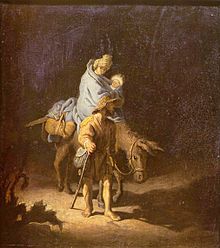Schau, lieber Gott, wie meine Feind, BWV 153
|
Schau, lieber Gott, wie meine Feind BWV 153 |
|
|---|---|
| Church cantata by J. S. Bach | |

|
|
| Occasion | Sunday after New Year's Day |
| Performed | 2 January 1724: Leipzig |
| Movements | 9 |
| Cantata text | anonymous |
| Bible text | |
| Chorale |
|
| Vocal | |
| Instrumental |
|
Schau, lieber Gott, wie meine Feind (See, dear God, how my enemies),BWV 153, is a church cantata by Johann Sebastian Bach. He composed it in Leipzig for the Sunday after New Year's Day and first performed it on 2 January 1724.
Bach wrote the cantata in his first year in Leipzig for the Sunday after New Year's Day and first performed it on 2 January 1724. The prescribed readings for the day are from the First Epistle of Peter, the suffering of Christians (), and from the Gospel of Matthew, the Flight into Egypt (). The unknown poet took Herod's Massacre of the Innocents and the Flight into Egypt as a starting point to reflect in general the situation of the Christians confronted with enemies. The poet is possibly the same person as the author of the two Christmas cantatas Darzu ist erschienen der Sohn Gottes, BWV 40, and Sehet, welch eine Liebe hat uns der Vater erzeiget, BWV 64, performed shortly before, because three hymn stanzas are featured in all three works. The cantata opens with a chorale, the first stanza of David Denicke's "Schau, lieber Gott, wie meine Feind" (1646). Movement 5 is stanza 5 of Paul Gerhardt's "Befiehl du deine Wege" (1656), known as movement 44 of the St Matthew Passion. The words speak of the utmost enemies: "Und ob gleich alle Teufel" (And even if all devils). The cantata ends with stanzas 16 to 18 of the chorale "Ach Gott, wie manches Herzeleid" (1587), attributed to Martin Moller. Bach would later write a chorale cantata Ach Gott, wie manches Herzeleid, BWV 3 on this chorale, and use its first stanza in Ach Gott, wie manches Herzeleid, BWV 58.
...
Wikipedia
